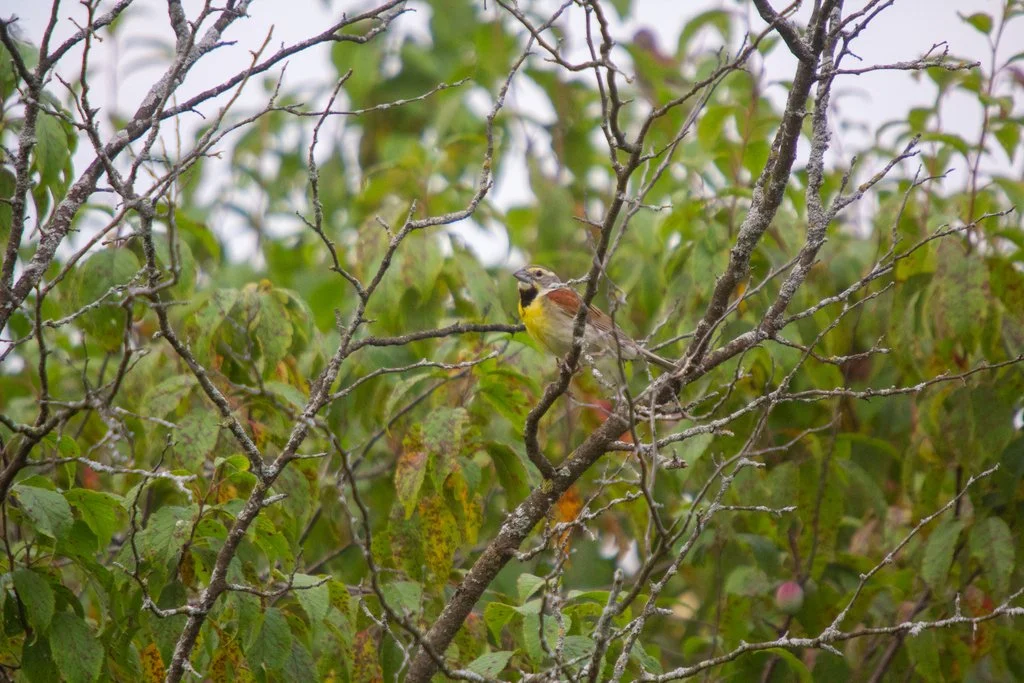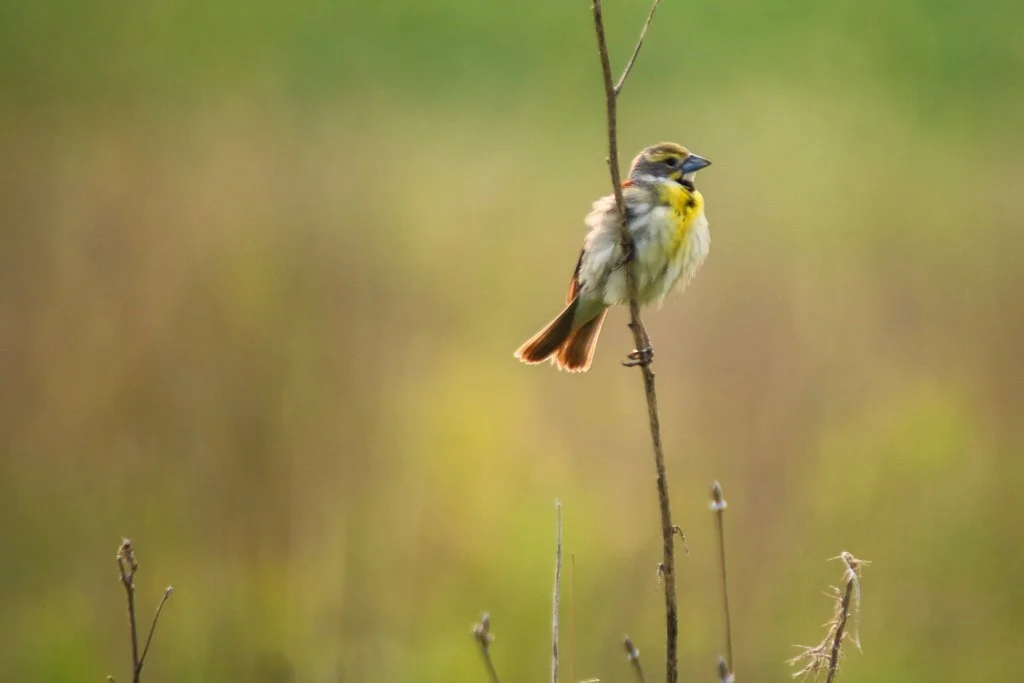If you’ve wandered through the prairies at Faville Grove Sanctuary in summer, especially along Prairie Lane, chances are you’ve heard a buzzy, rhythmic see-see, dic-dic, ciss-ciss-ciss ringing from the tops of prairie plants. This unique call belongs to the Dickcissel (Spiza americana)—a stocky, sparrow-like songbird with a vivid yellow chest and a signature black throat patch.
Taxonomists have had their hands full with this bird. The Dickcissel is the sole member of the genus Spiza, derived from the Ancient Greek for “finch.” Once classified with sparrows, then shuffled among blackbirds and orioles, it now tentatively resides in the cardinal family (Cardinalidae), alongside Indigo Buntings and Grosbeaks.
Roughly the size of a large sparrow, the Dickcissel measures about six inches long with a ten-inch wingspan. Males stand out with a bright yellow breast, black “V” across the throat, and chestnut shoulder patches that flash in flight. Their gray cheeks, pale conical bill, and white chin add to the sharp look. Females and juveniles are subtler, often mistaken for House Sparrows, though slimmer and longer-winged with faint yellow and a soft facial pattern.
Notice the subtler coloration on this juvenile Dickcissel compared to the bright yellow of the male (photo by Kelly Colgan Azar).
Dickcissels thrive in both remnant and restored prairies, particularly those with moderate to tall vegetation, dense litter, and a rich diversity of forbs. They require space to succeed—nesting is most successful in grasslands over 25 acres, and males may defend territories up to three acres in size. Polygyny is common; a single male may attract several females—sometimes up to six—when conditions are right.
Females build the nest alone, tucking it into low shrubs or dense grasses, well-hidden and often slightly off the ground. Clutches of 3–6 pale blue eggs hatch after an 11-day incubation. Chicks fledge 8–10 days later, fed largely on insect larvae. By late summer, fledglings begin to gather in loose flocks that soon swell in size.
Dickcissels arrive relatively late in southern Wisconsin—usually in late May or early June—and leave by mid-August. Their breeding window is short but dynamic. And their presence isn’t guaranteed every summer. That’s because Dickcissels are highly nomadic, responding to shifting weather, food availability, and habitat quality not only here, but across vast swaths of their range. In some years, they turn up far outside their typical Midwest core—nesting as far east as Pennsylvania and as far north as southern Canada.
As summer wanes, Dickcissels assemble in flocks numbering in the thousands, sometimes blanketing entire fields. These staging groups merge during migration, and by the time they reach their wintering grounds—primarily in Venezuela—flock sizes can reach into the millions.
Dickcissel perched on a tall prairie plant at Faville Grove (photo by Jeff Steele/SoWBA).
Despite their impressive abundance in some places, Dickcissels have faced serious declines. Between 1966 and 1979, populations fell by over 30%, and while numbers stabilized for a time, declines persist in some areas. The threats are especially grave on the wintering grounds. In parts of South America, Dickcissels are viewed as crop pests. Sugarcane fields have become deadly traps, where tens of thousands may be poisoned or shot in a single night. Though non-lethal deterrents are increasingly adopted, lethal control remains a significant threat.
At Faville Grove, the return of the Dickcissel each summer is no accident—it’s the result of years of careful stewardship, fire-managed prairies, and volunteers committed to conservation. Their buzzy chorus is the sound of healthy habitat, of tallgrass restored and thriving. If you’d like to help keep the prairie singing, we’d love to have you join us. (Learn about upcoming volunteer opportunities here.)
Written by Jeff Steele, Faville Grove Sanctuary land steward
Cover photo by Jeff Steele/SoWBA. A Dickcissel with bright yellow plumage on the chest with a black ‘v’ is perched in brushy vegetation.







